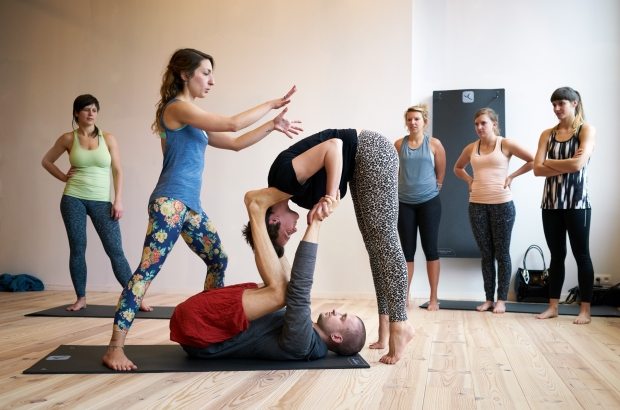- Daily & Weekly newsletters
- Buy & download The Bulletin
- Comment on our articles
Brussels couple introduces locals to acroyoga
While California beaches and London parks are filling up with acroyogis, Belgium is still new to the trendy practice that fuses yoga, acrobatics and Thai massage. A Flemish-Greek teaching duo now gives curious locals a chance to get a taste of the increasingly popular workout.
When entering the walk-in class led by Bart Adins and Christina Markouli in a large, lofty studio in the Sint-Gilles municipality of Brussels, I feel instantly welcome; the air is alive with chatter and laughter. After a short round of stretching, the circle ceremony – where all participants introduce themselves – serves as a bit of an icebreaker.
It’s also a rather necessary exercise, as things are about to get intimate. Acroyoga involves a lot of touching, which might push some attendees past their comfort zones. Ask yourself the question: Am I OK with holding a stranger’s naked foot in my hand?
Essentially, acroyoga is a partner-based practice where two or more people work together to form poses while balancing on each other. Here, you won’t do your handstand on a mat but on someone else’s body. Even the most basic poses easily look impressive and, admittedly, slightly intimidating.
But don’t let this put you off: Acroyoga doesn’t require any previous gymnastic or acrobatic experience at all. “What’s much more important is to be open-minded,” says Adins. “It’s less athletic and more a playful exploration of movement. Contrary to popular belief, even beginners manage very well, which is very empowering for them.”
Not-so quiet yoga
All positions, graced with fitting names such as High-Flying Whale or Back Bird, are demonstrated in detail by the instructor couple before the participants try them out themselves in teams of three. The “base” is the person on the ground, giving support to the “flyer” on top, while the “spotter” offers a helping hand and makes sure no-one falls.
Surprisingly, I even see a quite petite woman as a base, giving support to a much larger man: Technique is clearly more important than strength in acroyoga.
The trios take their time to find the right positions, carefully manoeuvring their bodies until they find stability. There is no pressure, no competition and no embarrassment when a position doesn’t work out. And nobody got hurt.
As communication is key, there’s a lot of talking going on – quite a change to the introspective, meditative nature of traditional yoga. “You have to really feel and listen to the other person and anticipate your partner’s movements,” Adins explains.
Acroyoga first emerged in the late 1990s at two yoga schools – one in Montreal and one in California. But the sport only really gained momentum in recent years, when celebrities – from Lena Dunham to Adam Levine and Ashley Judd – started posting photos of the visually beautiful workouts on Instagram.
Acroyoga has taken social media by storm and is now a major tool for its avid fan base to exchange tips and learn about new positions. Adins and Markouli are the perfect example: They met through an acroyoga Facebook group.
Couple’s therapy
“In the beginning, we were just a bunch of friends meeting up and trying to imitate what we saw on YouTube videos,” Markouli remembers. The few acroyoga teachers in Belgium today all have ties going back to this passionate, self-taught little crew. Adins and Markouli provide the lessons in both Brussels and Ghent.
Although social media is largely responsible for acroyoga’s recent rise, the movement was initially meant as an antipode to a society that is increasingly ruled by internet technology. One of its main goals is to encourage human connection and foster physical and emotional interactions.
In the end, you will only be able to master the positions with the necessary amount of communication and overall trust. No wonder some psychologists even prescribe acroyoga as couple’s therapy.
At the end of the session, everyone once again gathers in a circle, which has visibly become closer. “We start out as strangers and end by massaging each other,” Markouli says. “This is exactly why I love this sport so much – because of the immense community feeling.”
Acroyoga proved to be a fun, relaxing and rewarding experience that is uplifting in the literal sense of the word – even and especially for first-timers. For those who are still hesitating: No, you won’t break your neck, and you don’t need special talents. Just an open mind.
Photo: Rudy Carlier










Comments
More information on our weekly classes and workshops on
http://www.belgiumrolfing.com/acroyoga/